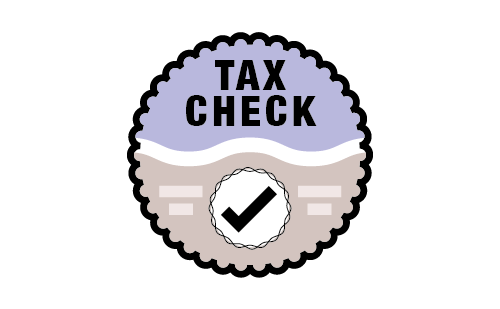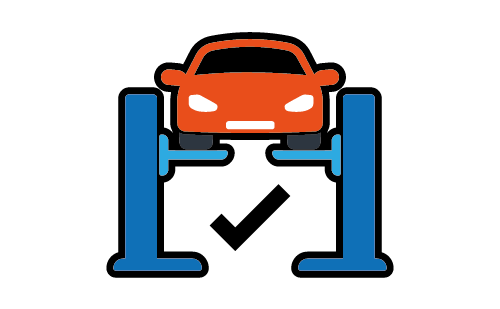Check my car year by reg plate
Want to know the year of a UK-registered vehicle?
Simply enter the registration number into our Car Year Checker tool.


What year is my car?
There are many reasons why you may need to know the year of a car.
For instance, if you are planning to sell your car, you’ll need to disclose its year to any prospective buyers. When purchasing a replacement part for your vehicle, you’ll have to make sure it is compatible with your car by checking its model and year – and of course, before committing to your next car purchase, you’ll almost certainly want to know the years of any vehicles you are considering.
Whatever the reason, you’ll be pleased to know that there are several simple methods at your disposal to help you identify a vehicle’s year or age. In this guide, we will cover how to use our Car Year Checker tool to identify the year of any UK-registered car.
We’ll also explain how to read new, prefix and suffix-style number plates to instantly identify a vehicle’s registration year. Finally, we’ll cover dateless number plates - and how to identify the year and age of any vehicles that have them.
New-style car registration years chart (2001 onwards)
Any vehicles that were registered on or after 1st September 2001 utilise the new-style number plate format (unless they have a dateless plate).
With this number plate format, the first two letters indicate the area where the vehicle was initially registered. The two numbers that follow denote the vehicle’s age. The last three characters do not provide any specific vehicle information.
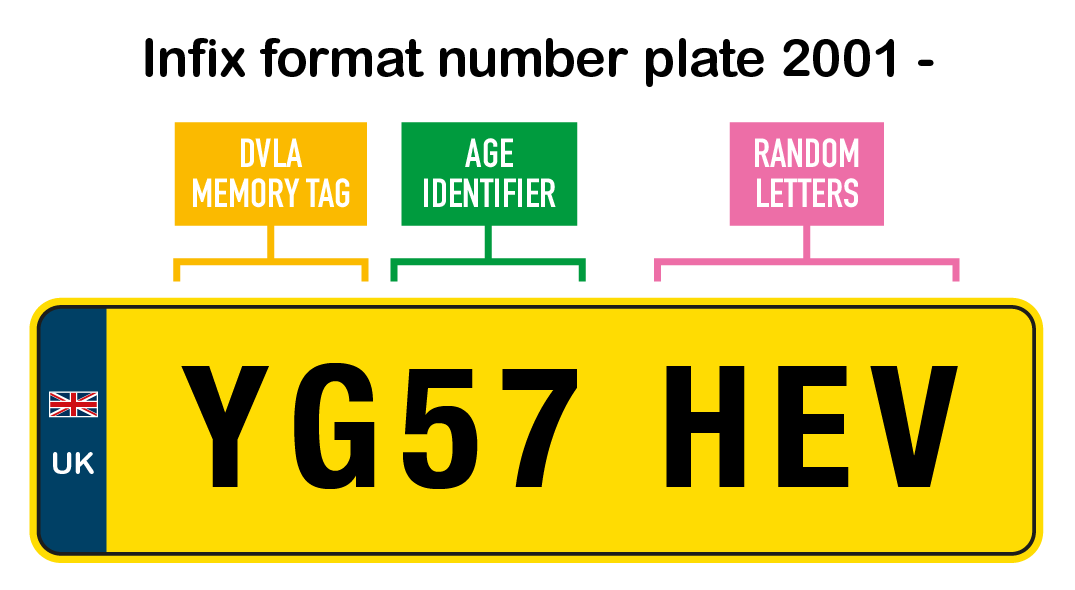
To determine the registration year of your vehicle, please refer to the chart below:
| Plate | From | To |
|---|---|---|
| 51 | Sep-01 | Mar-02 |
| 2 | Mar-02 | Sep-02 |
| 52 | Sep-02 | Mar-03 |
| 3 | Mar-03 | Sep-03 |
| 53 | Sep-03 | Mar-04 |
| 4 | Mar-04 | Sep-04 |
| 54 | Sep-04 | Mar-05 |
| 5 | Mar-05 | Sep-05 |
| 55 | Sep-05 | Mar-06 |
| 6 | Mar-06 | Sep-06 |
| 56 | Sep-06 | Mar-07 |
| 7 | Mar-07 | Sep-07 |
| 57 | Sep-07 | Mar-08 |
| 8 | Mar-08 | Sep-08 |
| 58 | Sep-08 | Mar-09 |
| 9 | Mar-09 | Sep-09 |
| 59 | Sep-09 | Mar-10 |
| 10 | Mar-10 | Sep-10 |
| 60 | Sep-10 | Mar-11 |
| 11 | Mar-11 | Sep-11 |
| 61 | Sep-11 | Mar-12 |
| 12 | Mar-12 | Sep-12 |
| 62 | Sep-12 | Mar-13 |
| 13 | Mar-13 | Sep-13 |
| 63 | Sep-13 | Mar-14 |
| 14 | Mar-14 | Sep-14 |
| 64 | Sep-14 | Mar-15 |
| 15 | Mar-15 | Sep-15 |
| 65 | Sep-15 | Mar-16 |
| 16 | Mar-16 | Sep-16 |
| 66 | Sep-16 | Mar-17 |
| 17 | Mar-17 | Sep-17 |
| 67 | Sep-17 | Mar-18 |
| 18 | Mar-18 | Sep-18 |
| 68 | Sep-18 | Mar-19 |
| 19 | Mar-19 | Sep-19 |
| 69 | Sep-19 | Mar-20 |
| 20 | Mar-20 | Sep-20 |
| 70 | Sep-20 | Mar-21 |
| 21 | Mar-21 | Sep-21 |
| 71 | Sep-21 | Mar-22 |
| 22 | Mar-22 | Sep-22 |
| 72 | Sep-22 | Mar-23 |
| 23 | Mar-23 | Sep-23 |
| 73 | Sep-23 | Mar-24 |
| 24 | Mar-24 | Sep-24 |
Prefix car registration years chart (1983-2001)
Vehicles registered between 1st August 1983 and 31st August 2001 will have a prefix-format registration plate - unless they have a dateless registration plate.
With a prefix-style registration plate, the first character is the age identifier. The next three characters are sequential numbers – and the last three letters indicate where the vehicle was registered.
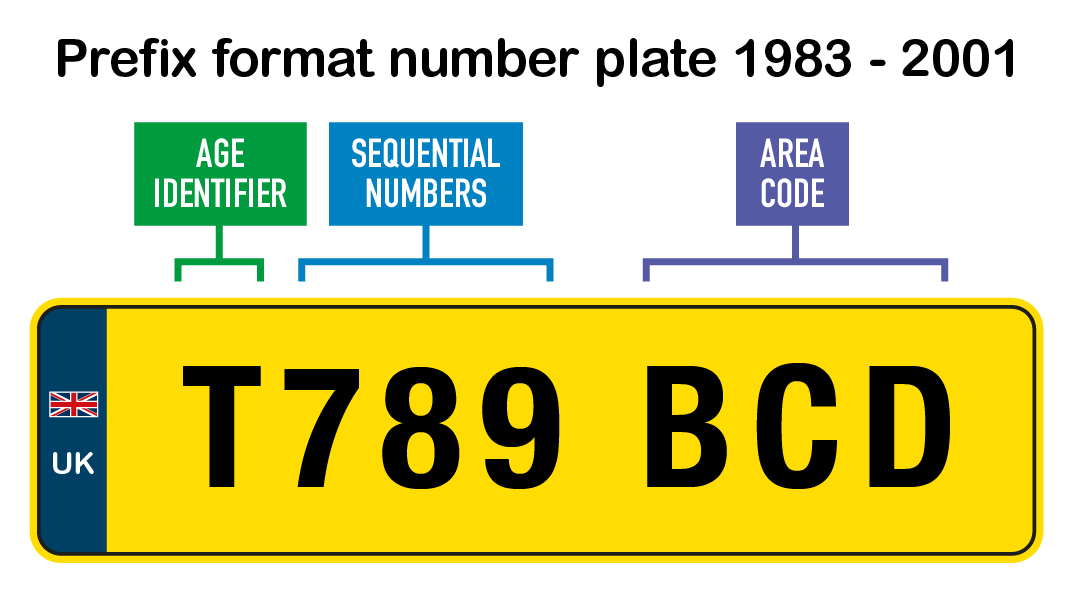
To determine the registration year of your prefix-plated vehicle, please refer to the chart below:
| Letter | From | To |
|---|---|---|
| A | 01-Aug-83 | 31-Jul-84 |
| B | 01-Aug-84 | 31-Jul-85 |
| C | 01-Aug-85 | 31-Jul-86 |
| D | 01-Aug-86 | 31-Jul-87 |
| E | 01-Aug-87 | 31-Jul-88 |
| F | 01-Aug-88 | 31-Jul-89 |
| G | 01-Aug-89 | 31-Jul-90 |
| H | 01-Aug-90 | 31-Jul-91 |
| J | 01-Aug-91 | 31-Jul-92 |
| K | 01-Aug-92 | 31-Jul-93 |
| L | 01-Aug-93 | 31-Jul-94 |
| M | 01-Aug-94 | 31-Jul-95 |
| N | 01-Aug-95 | 31-Jul-96 |
| P | 01-Aug-96 | 31-Jul-97 |
| R | 01-Aug-97 | 31-Jul-98 |
| S | 01-Aug-98 | 28-Feb-99 |
| T | 01-Mar-99 | 31-Jul-99 |
| V | 01-Aug-99 | 28-Feb-00 |
| W | 01-Mar-00 | 31-Jul-00 |
| X | 01-Aug-00 | 28-Feb-01 |
| Y | 01-Mar-01 | 31-Aug-01 |
Suffix car registration years chart (1963-1983)
With a suffix registration plate, the first three letters denote the location where the vehicle was registered. This is followed by three random numbers – and the final letter is the age-identifier.
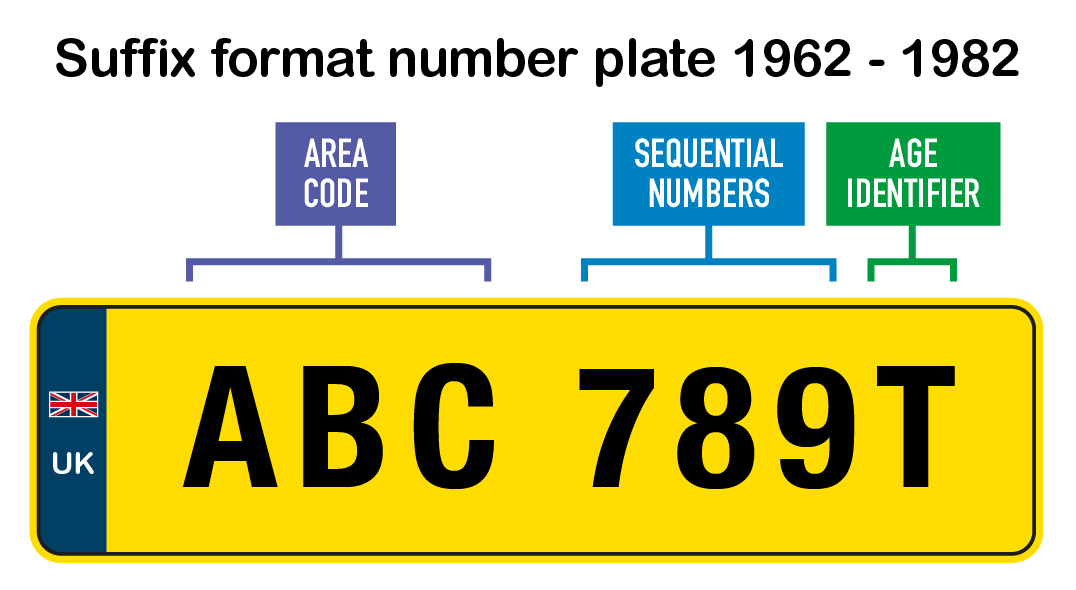
To determine the registration year of your suffix-plated vehicle, please refer to the chart below:
| Letter | From | To |
|---|---|---|
| A | 01-Feb-63 | 31-Dec-63 |
| B | 01-Jan-64 | 31-Dec-64 |
| C | 01-Jan-65 | 31-Dec-65 |
| D | 01-Jan-66 | 31-Dec-66 |
| E | 01-Jan-67 | 31-Jul-67 |
| F | 01-Aug-67 | 31-Jul-68 |
| G | 01-Aug-68 | 31-Jul-69 |
| H | 01-Aug-69 | 31-Jul-70 |
| J | 01-Aug-70 | 31-Jul-71 |
| K | 01-Aug-71 | 31-Jul-72 |
| L | 01-Aug-72 | 31-Jul-73 |
| M | 01-Aug-73 | 31-Jul-74 |
| N | 01-Aug-74 | 31-Jul-75 |
| P | 01-Aug-75 | 31-Jul-76 |
| R | 01-Aug-76 | 31-Jul-77 |
| S | 01-Aug-77 | 31-Jul-78 |
| T | 01-Aug-78 | 31-Jul-79 |
| V | 01-Aug-79 | 31-Jul-80 |
| W | 01-Aug-80 | 31-Jul-81 |
| X | 01-Aug-81 | 31-Jul-82 |
| Y | 01-Aug-82 | 31-Jul-83 |
How can I tell my car’s year of manufacture by VIN number?
You can identify a vehicle’s year of manufacture by referring to the 10th digit in the VIN code. The year of manufacture is represented by either a letter or a number, depending on the age of the vehicle.
Vehicle Identification Number – Year code chart
To determine your car’s year of manufacture, check the 10th digit of its VIN code against the following chart:
| Code | Year | Code | Year | Code | Year | ||
|---|---|---|---|---|---|---|---|
| A | 1980 | X | 1999 | J | 2018 | ||
| B | 1981 | Y | 2000 | K | 2019 | ||
| C | 1982 | 1 | 2001 | L | 2020 | ||
| D | 1983 | 2 | 2002 | M | 2021 | ||
| E | 1984 | 3 | 2003 | N | 2022 | ||
| F | 1985 | 4 | 2004 | P | 2023 | ||
| G | 1986 | 5 | 2005 | R | 2024 | ||
| H | 1987 | 6 | 2006 | S | 2025 | ||
| J | 1988 | 7 | 2007 | T | 2026 | ||
| K | 1989 | 8 | 2008 | V | 2027 | ||
| L | 1990 | 9 | 2009 | W | 2028 | ||
| M | 1991 | A | 2010 | X | 2029 | ||
| N | 1992 | B | 2011 | Y | 2030 | ||
| P | 1993 | C | 2012 | 1 | 2031 | ||
| R | 1994 | D | 2013 | 2 | 2032 | ||
| S | 1995 | E | 2014 | 3 | 2033 | ||
| T | 1996 | F | 2015 | 4 | 2034 | ||
| V | 1997 | G | 2016 | 5 | 2035 | ||
| W | 1998 | H | 2017 | 6 | 2036 |
Dateless number plate types
Some number plates are dateless, meaning it is not possible to determine the vehicle’s registration year by reading them. If a number plate is dateless and the vehicle is registered in the UK, you can still identify its year of registration by running the registration number through our Car Year Checker tool.
There are several different types of dateless number plates, which are highlighted below:
Dateless UK number plates (issued before 1963)
Dateless or ‘cherished’ number plates were issued for UK-registered vehicles until 1963, when the suffix format plates replaced them. The first dateless plate was issued in 1903 - and registration plates became compulsory the following year, so that vehicles and motorists could be identified.
Personalised number plates
You can buy a private (personalised) registration from the DVLA or a dealer, providing it is not already in use. However, you cannot put a registration plate on your vehicle that would make it appear newer than it is (e.g. placing a ‘63’ plate on a 2009 car).
Years of manufacture for Northern Irish number plates
As all Northern Irish number plates are dateless, they can be assigned to vehicles of any age, unlike the new, prefix and suffix-style plates commonly seen on vehicles registered in the rest of the UK. This plate format features a serial letter, county code and up to four numerical digits.
Q plates
The DVLA issues ‘Q’ registration numbers when a vehicle’s age or identity cannot be reliably verified. Given that they are issued when a vehicle’s age is not known, Q plates are also dateless. To obtain a ‘Q’ registration number, a vehicle must pass a type approval process.

Frequently asked questions
Sometimes, a car’s registration year will differ from its year of manufacture. The number plate - or Vehicle Registration Mark (VRM) indicates when a vehicle was first registered. The year of manufacture is listed in the V5C logbook - and can also be determined by reading the VIN number.
You can determine the age of most UK vehicles by reading the registration plate. However, some plates, including personalised, ‘Q’ and Northern Irish plates are dateless. When this is the case, you can determine vehicle age by checking the V5C logbook or using our Car Year Checker tool.
According to the DVLA, you cannot put a number plate on a vehicle that would make it appear newer. For instance, you would not be able to place a plate containing the number ‘19’ on a vehicle made in 2011. The DVLA also forbids personalised plates for Q-plated cars.
The oldest type of UK number plate, issued between 1903 and 1963 was dateless, meaning there was no way to determine the age of a vehicle without insider knowledge. Most number plates issued since then carry ‘age identifiers’, allowing the vehicle’s age to be read on the spot.
From January 1st 1904, it became compulsory for every car on the road to be registered with a number plate, which had to be displayed in a prominent position. The legislation was introduced under the Motor Car Act 1903, so that vehicles and drivers could be easily identified.
With prefix number plates (1983-2001), the age identifier denoting the registration year was the first letter on the plate. With suffix plates (1963-1983), the age identifier was the last letter on the plate. Number plates issued prior to this lacked any age identifiers.
Northern Irish number plates contain a serial letter and county code (denoting where the vehicle was registered) and a number sequence (up to four digits). However, these plates are dateless, meaning you must refer to the V5C logbook, VIN number or a Car Year Checker tool to determine the year.
If your car has a standard (new, suffix or prefix-style) number plate, this is unlikely to affect your car valuation. Conversely, dateless number plates are often sought-after – and the more in demand your registration number is, the greater the potential increase in your car’s value.


Our other tools
We’re rated ‘Excellent’ on Trustpilot
Data presented in webuyanycar car, tax and MOT check contains public sector information licensed under the Open Government Licence v3.0 of which we assume is correct at the time of presentation to the consumer.


